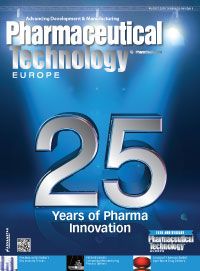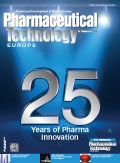No Signs of a Slowdown in Mergers
Pharmaceutical Technology Europe
A review of how mergers and acquisitions have shaped the pharmaceutical industry landscape.

A new round of pharmaceutical industry mergers and acquisitions (M&As) are on the horizon, judging by the series of announcements and rumours circulating the media during the first half of the year (1, 2). It was suggested that in one week of April, the total value of various rumoured deals was of the order of US$100 billion, illustrating how cash-rich major pharmaceutical companies are (2). Many of the larger companies looking for deals are themselves the product of a series of M&As that took place over the past two decades. Critics have long argued that previous mergers have not made these companies more efficient, and that their failure to achieve the growth targets promised to investors is why they continue to seek tie ups with other companies possessing lucrative blockbuster products and promising drug pipelines (3-5). Nevertheless, companies believe that such deals can add value in the long run for their shareholders. In fact, judging by stock market performance, it would appear that the major companies are performing well financially (6).
There has been particular interest in Pfizer’s series of bids to acquire AstraZeneca, which were turned down and led to intervention by UK politicians seeking assurances over local jobs (1, 7). Rumours have also circulated that AbbVie or Amgen might be more suitable partners for AstraZeneca (8). Interestingly, AbbVie has made an offer for Shire, which has so far been rejected (9). Despite not being described as a merger or an acquisition, one significant deal was a swap of assets between GlaxoSmithKline and Novartis, where the two companies exchanged parts of their oncology and vaccine businesses and also launched a joint venture for certain products in the consumer healthcare sector (1).
A long history of mergers
Historically, the pharmaceutical industry has seen sequential waves of M&As. In 1985, the 10 largest pharmaceutical companies accounted for approximately 20% of worldwide sales (3). As consolidation began to occur within the industry, the top 10 companies were able to significantly expand their share of global sales and thus dominate the international market. This trend has continued to the present day. In 2012, the global share of the top 10 pharmaceutical companies reached 42% (10).
In many cases, the main reason for pursuing a tie-up with another company has been to improve R&D productivity, although it does not always work. By combining R&D programmes, companies believe they will be in a better position to boost new drug output in diverse therapeutic areas. When GlaxoWellcome merged with SmithKline Beecham in 2000, one of the R&D advantages cited for the deal was SmithKline Beecham’s exciting genetics research programmes (11). For Swiss-based Roche, the 2009 merger with US Genentech enabled access to the Californian company’s strong biotech R&D programme. The post-merger company’s R&D programme was considered such a success, particularly in oncology, that it led to the closure of Roche’s former US research facilities in Nutley, New Jersey (12). More recently, the 2011 acquisition of Genzyme by Sanofi has enabled the company to benefit from the smaller firm’s rare diseases R&D pipeline (13).

Pharmaceutical Technology Europe25th Anniversary Issue
For pharmaceutical companies evaluating M&As, the increasing costs to develop and launch new drugs is an ongoing concern. Between 1995 to 2000, the cost to successfully launch a new drug was estimated at US$1.1 billion, but by 2002, the associated costs rose to approximately US$1.7 billion (14). Increased spending on R&D, however, does not guarantee productivity given that attrition rates (i.e., failure to enter the next stage of the R&D process) are considerable. Worryingly, the failure rate for drugs in Phase III trials that have already shown promise in Phase II trials can be as high as 50% (15). Because high drug failure rates contribute substantially to R&D costs, only bigger companies can afford to invest in large portfolios, knowing that certain drugs will not make it through to approval. Pfizer, which has grown through a series of M&As over the past decade, was previously able to manage a US$9.4 billion R&D budget in 2010. However, its merger with Wyeth was believed to have significantly added to its research costs, and the company is now trying to scale back its R&D expenses to around US$7 billion (16).
Another reason to pursue M&As is to increase revenues to help fund larger R&D programmes as well as to compensate for lost sales from products going off patent. Merging with a company that has a different portfolio of products can strengthen one’s presence in a particular therapeutic area or even help gain quick entry into a new therapeutic area. Furthermore, because the other company is likely to be already operating in such areas, a “ready-made” sales force may be available. When Pfizer merged with Pharmacia in 2002, a major attraction was the blockbuster drug Celebrex, but it also enabled the two companies to combine their strong cardiovascular portfolios (17).
Globalisation
As the pharmaceutical market expands internationally, companies have realised that carefully thought-out M&As can open up new geographical advantages. Sanofi is one company that has used mergers in this way. The company was founded in 1973 in France and grew steadily in Europe through the 1980s through acquisitions. In 1994, it acquired Sterling Winthrop, which enabled it to enter the US market (13). In 2004, Sanofi merged with Aventis, itself a top 10 company, which subsequently positioned the merged company as a significant global player (13).
Although the pharmaceutical markets of US, Europe and Japan still represent the majority of global sales, emerging markets are growing at a faster annual rate. It has been predicted that these markets will account for nearly a third of the global pharmaceutical market by 2016 (18); therefore, companies are looking to these markets to drive their long-term growth plans. Although mergers between large organisations can offer automatic presence in emerging markets, companies have also selected local players as part of a dedicated expansion strategy. Between 2008 and 2012, the proportion of major company deals in the emerging markets was approximately 20%, with a high number of targets being sought in Latin America, China and India (19). Acquiring a domestic company can give a larger company unique insight into the local market as well as specialised infrastructure.
Sanofi has been making a series of targeted investments to expand its sales in Latin America. In 2009, it bought the Mexican company Laboratorios Kendrick for an undisclosed sum, and then followed up with a US$660-million acquisition of the Brazilian generics company Medley, and in 2012, bought the Colombian Genfar (20). As part of its strategy to become a leader in the Chinese vaccine market, in 2011, Novartis acquired a majority stake in the Chinese vaccines company Zhejiang Tianyuan. The Chinese firm was one of the largest privately held vaccines companies in the country (21).
One proposed merger that will shape the Indian market is that between Sun Pharmaceutical Industries and Ranbaxy, but the deal was initially halted by the High Court of the southern state of Andhra Pradesh (22). Interestingly, Japan’s Daiichi Sankyo had previously acquired a 64% share of Ranbaxy but the deal proved to be a disappointment and so the company is keen to sell its share. Ranbaxy has been struggling in the US market due to manufacturing-related problems, which have led to action being taken by the FDA (22). Daiichi Sankyo’s acquisition of a majority stake in Ranbaxy illustrates the importance of the due diligence that outside companies must perform before buying a local company. Despite the serious challenges facing Ranbaxy, Sun Pharmaceutical appears to see potential from a domestic merger. Certainly, if it goes ahead, the merged company will dominate the Indian market.
Future outlook
M&As are taking place all the time in the pharmaceutical sector. Over time, the industry has become increasingly consolidated but there is no sign that this trend will slow down. Such deals have been crucial to the success of the top 10 pharmaceutical companies as they continue to seek further targets to drive expansion. A particularly important factor for these M&A plans is expansion into emerging markets, which continue to represent highly promising areas for long-term growth.
References
1. The Guardian, Pharma ‘blockbuster’ rumours swirl after Glaxo and Novartis deals,” Press Release, 22 Apr 2014.
2. Bloomberg, Pharma Mergers Make Sense,” accessed 1 Jul 2014.
3. P. Danzon et al., NBER Working Paper 10536, accessed 1 Jul 2013.
4. B. Munos, Nat Rev Drug Discov 8 (12) 959-968 (2009).
5. Pharma Manufacturing, “Mergers and Acquisitions Have Failed to Build Value for Pharma,” accessed 1 Jul 2014.
6. Forbes, “Grading Pharma In 2013: 16 Drug Companies Ranked,” accessed 1 Jul 2014.
7. BBC, “Pfizer drops AstraZeneca takeover bid,” accessed 1 Jul 2014.
8. Bloomberg, “Amgen, AbbVie Seen as Possible AstraZeneca White Knights,” Press Release, 28 Apr 2014.
9. The Guardian, “Shire fends off takeover bid from US rival AbbVie with growth plans,” Press Release, 23 Jun 2014.
10. W. Noor and M. Kleinrock, Pharm Exec 33 (5) 19-29 (2013).
11. WSJ, “Glaxo Wellcome Agrees to Acquire SmithKline Beecham for $75.7 Billion,” accessed 1 Jul 2014.
12. Reuters, “Analysis: After Roche merger, biotech tail wags big pharma dog,” accessed 1 Jul 2014.
13. Sanofi, www.sanofi.co.uk.
14. R. Mahajan and K Gupta, J Pharm Bioallied Sci 2 (4) 307-313 (2010).
15. J.A. DiMasi et al., Clin Pharmacol Ther 87 (3) 272-7 (2010).
16. Forbes, “Potential Impact On R&D Of A Pfizer Takeover Of AstraZeneca," accessed 1 Jul 2014.
17. WSJ, “Pfizer to Buy Pharmacia For $60 Billion in Stock,” accessed 1 Jul 2014.
18. Booz & Co., “Pharma Emerging Markets 2.0,” accessed 1 Jul 2014.
19. Cepton, “Pharmaceuticals Mergers & Acquisitions,” accessed 1 Jul 2014.
20. Sanofi, “Sanofi to Acquire Genfar S.A., a Leader in Pharmaceutical Medicines in Colombia,” Press Release, 12 Oct 2012.
21. Novartis, “Novartis completes acquisition of majority stake in Zhejiang Tianyuan expanding vaccines presence in China,” Press Release, 22 Mar 2011.
22. WSJ, “Indian Court Temporarily Halts Ranbaxy-Sun Pharmaceutical Merger,” accessed 1 Jul 2014.

About the Author
Faiz Kermani is a freelance writer based in France.

Drug Solutions Podcast: A Closer Look at mRNA in Oncology and Vaccines
April 30th 2024In this episode fo the Drug Solutions Podcast, etherna’s vice-president of Technology and Innovation, Stefaan De Koker, discusses the merits and challenges of using mRNA as the foundation for therapeutics in oncology as well as for vaccines.
Drug Solutions Podcast: Gliding Through the Ins and Outs of the Pharma Supply Chain
November 14th 2023In this episode of the Drug Solutions podcast, Jill Murphy, former editor, speaks with Bourji Mourad, partnership director at ThermoSafe, about the supply chain in the pharmaceutical industry, specifically related to packaging, pharma air freight, and the pressure on suppliers with post-COVID-19 changes on delivery.
PacBio Chosen as Tech Partner for Global Alzheimer’s Disease Research Project
April 23rd 2025The project, the North African Dementia Registry, will unite multiple entities for the purpose of developing a comprehensive dataset to advance the research community’s understanding of Alzheimer’s disease and other dementias in diverse populations.